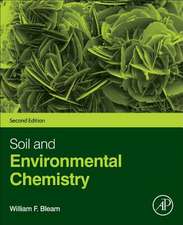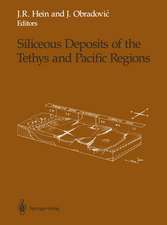Soils and Environmental Quality
Autor Gary M. Pierzynski, George F. Vance, J. Thomas Simsen Limba Engleză Hardback – 2 mai 2005
The text moves from the theoretical to the practical with an abundance of contemporary examples, such as an exploration of allowable pesticide concentrations in drinking water and an inquiry into soil contamination from the trace elements in organic by-products. Also considered are the use of soil carbon sequestration as a remedy for global climate change, and the effects of acid precipitation on forestation.
NEW TO THE THIRD EDITION:
· New chapters on nutrient management planning, and the environmental testing of soil, plants, water, and air
· Additional and revised case studies that continue to relate academic content to real-life situations, while inspiring students with real –life challenges to solve
· Eight-page color inset
· Direct encouragement and links to fully access the Internet as a resource for the most up-to-date findings
Always Relevant, Always Interesting
The text also covers environmentally-related current events, fostering discussion of the political, economic, and regulatory aspects of environmental issues, the human side of environmental problems, the use and misuse of the scientific method, and potential bias in the presentation of facts. Students in soil science, environmental science, chemistry, biology, geology, and other disciplines will gain valuable insight from this multifaceted text.
Preț: 810.52 lei
Preț vechi: 988.44 lei
-18% Nou
Puncte Express: 1216
Preț estimativ în valută:
155.09€ • 168.100$ • 130.69£
155.09€ • 168.100$ • 130.69£
Carte tipărită la comandă
Livrare economică 23 aprilie-07 mai
Preluare comenzi: 021 569.72.76
Specificații
ISBN-13: 9780849316166
ISBN-10: 0849316162
Pagini: 592
Ilustrații: 184 b/w images and Placed all files for EB to InSite for 3rd print
Dimensiuni: 178 x 254 x 37 mm
Greutate: 1.26 kg
Ediția:3Revizuită
Editura: CRC Press
Colecția CRC Press
Locul publicării:Boca Raton, United States
ISBN-10: 0849316162
Pagini: 592
Ilustrații: 184 b/w images and Placed all files for EB to InSite for 3rd print
Dimensiuni: 178 x 254 x 37 mm
Greutate: 1.26 kg
Ediția:3Revizuită
Editura: CRC Press
Colecția CRC Press
Locul publicării:Boca Raton, United States
Public țintă
UndergraduateCuprins
Introduction to Environmental Quality. Our Environment: Atmosphere and Hydrosphere. Our Environment: Soil Ecosystems. Environmental Testing: Soils, Waters, Plants, Wastes, Organics. Soil Nitrogen and Environmental quality. Soil Phosphorus and Environmental Quality. Soil Sulfur and Environmental Quality. Nutrient Management Planning. Trace Elements. Organic Chemicals in the Environment. The Atmosphere: Global Climate Change and Acidic Deposition. Remediation of Soil and Ground water. Risk Assessment.
Recenzii
"This is a solid undergraduate textbook on some of the critical soil environment issues facing society."
– Edmund Perfect, Department of Earth and Planetary Sciences, University of Tennessee, in Vadose Zone Journal, August 2009, Vol. 8, No. 3
– Edmund Perfect, Department of Earth and Planetary Sciences, University of Tennessee, in Vadose Zone Journal, August 2009, Vol. 8, No. 3
Notă biografică
Gary M. Pierzynski, George F. Vance, Thomas J. Sims
Descriere
A perpetual bestseller, this third edition explores environmental quality from the perspective of soil science. The coverage ranges from the theoretical to the practical with an abundance of examples such as an exploration of allowable pesticide concentrations in drinking water and an inquiry into soil contamination from the trace elements in organic by-products. It also explores the use of soil carbon sequestration as a remedy for global climate change and the effects of acid precipitation on forestation. Case studies with political, economic, and legal implications illustrate the human side of environmental problems. Also covered is the use or misuse of the Scientific Method and the potential for factual bias.


























